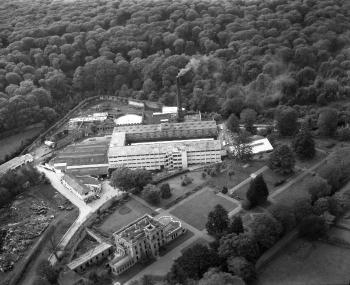 Portlaw today is a quiet peaceful village, situated approximately twelve miles from the city of Waterford. It lies on the river Clodagh - a small tributary of the once vibrant river Suir. To many Portlaw may seem like any other small village of Ireland, lying a stone's throw from Lord Waterford's seat at Curraghmore. To those, however, who know Portlaw and are familiar with it's history, realise that it has much more to offer. It holds a wealth of history, and to it's inhabitants a secure feeling of home. I feel for Portlaw just as any 'native may, because I am a native of this small, yet beautiful village. Being a native of Portlaw, obviously was the main source of motivation in choosing Portlaw as a study area. Also, inevitably, I had a brief knowledge of it's famous background and it proved quite interesting and fascinating to me.
Portlaw today is a quiet peaceful village, situated approximately twelve miles from the city of Waterford. It lies on the river Clodagh - a small tributary of the once vibrant river Suir. To many Portlaw may seem like any other small village of Ireland, lying a stone's throw from Lord Waterford's seat at Curraghmore. To those, however, who know Portlaw and are familiar with it's history, realise that it has much more to offer. It holds a wealth of history, and to it's inhabitants a secure feeling of home. I feel for Portlaw just as any 'native may, because I am a native of this small, yet beautiful village. Being a native of Portlaw, obviously was the main source of motivation in choosing Portlaw as a study area. Also, inevitably, I had a brief knowledge of it's famous background and it proved quite interesting and fascinating to me.
Any person observing Portlaw today can immediately perceive that it is like so many of Ireland's towns and villages, suffering under the hands of the depression. However, there was a time when it probably was one of the more prosperous towns of Ireland. The origins of this long gone prosperity and Portlaw itself lie in a cotton factory - Mayfield Mill - as it was known. The age of this prosperity was back in the nineteenth century. It was a place that rose out of nothing but a few mud cabins, which date back to around 1821. The transformers of the village were the Quaker family of the Malcolmsons. It was they who built the few mud cabins into a model township.
In researching Portlaw as an industrial village, one of the most irritating and salient factors that befell me was that I feel - and hope that any reader of these pages will come to realise - that the village of Portlaw has never been given enough recognition as a model industrial village. The most any writers have attributed to it is a parenthetic reference. Portlaw was a thriving, vibrant, self-sufficient community, when other parts of Ireland were decaying under the ravages of the famine. It was a home and a place of work for thousands. It came to be more than a thriving community however, it turned out to be a model village and it was preceded by Bessbrook in County Armagh. Ironically many geographers whilst referring to the model townships of the Industrial revolution mention Bessbrook in relation to Ireland, yet fail to recognise that Portlaw was the inspiration behind Bessbrook and it also said that Cadburys, when building their village of Bournville had Portlaw in mind - at least it's layout.
In praising the Malcolmson family and their developments in Portlaw, I am not saying that they were unique. There were many more industrialists who like the Malcolmsons built model villages for their workers. One could say, that they all contained the germ of the idea which Howard and many other planners were to propagate. All can be regarded as embryonic garden cities. Although Industrial villages and garden cities are clearly two different phenomenon, they both aimed for a combination of working and living in a healthy environment. In my endeavour I have tried to give the reader as concise an insight as possible into the birth and literally death of the village of Portlaw. Portlaw was born out of industrial prosperity and has right up until today continued to be effected by the ebb and flow of this prosperity. Portlaw has contracted in size and population since the fall of the cotton factory and the Malcolmson family. Contemporary Portlaw is a reflection of what transpired over one hundred and fifty years ago. Portlaw's layout and structure is a fossil of what once was a landmark of Ireland. The sense of community pride that exists today in Portlaw as regards its history is a living tribute to the family of the Malcolmsons, the propagators of village life in Portlaw.
Author: Tina Foran